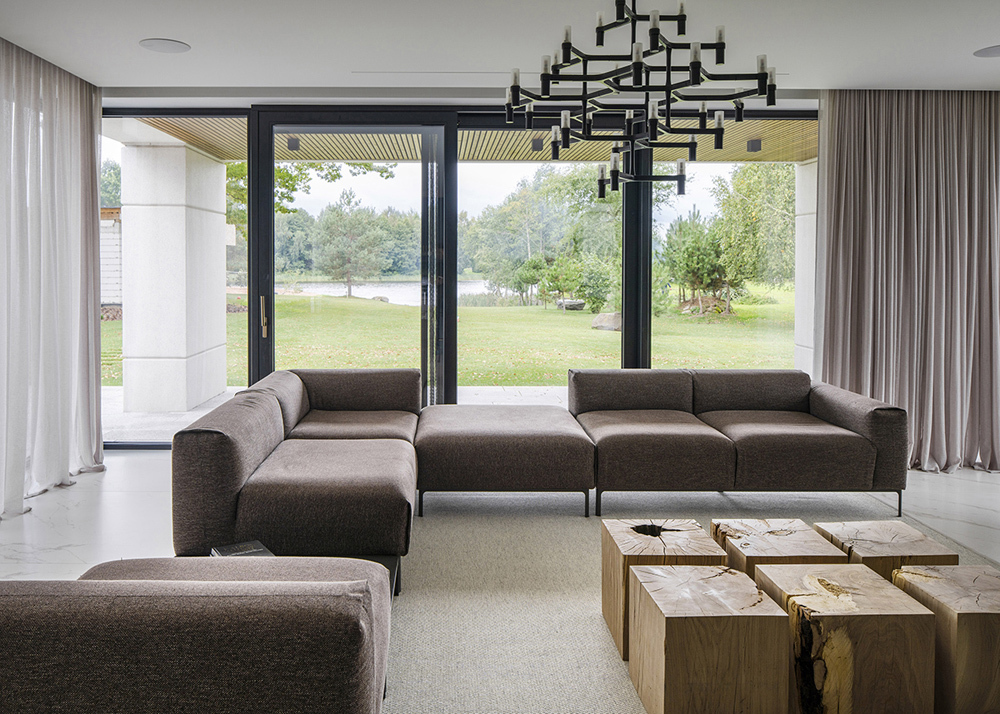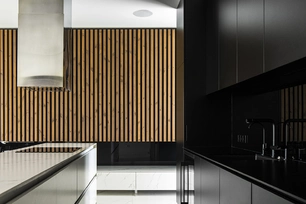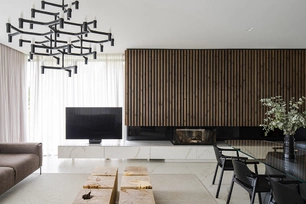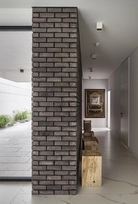Apie projektą:
Šalis: Lietuva
Plotas: 301 m2
Šeimos vila po ąžuolais
Jaunos šeimos vila šimtamečių ąžuolų, tvenkinio ir pievų apsuptyje – pastatyta toliau nuo miesto, atsiskyrėliškai ramios gyvenimo tėkmės ieškančiam žmogui. Du į vandenį atgręžti gyvenamosios ir poilsio zonos tūriai, sujungti perregima stiklo galerija, neužstojančia pagrindiniu taku ateinančiojo žvilgsnio. Deginta mediena, naturalus akmuo, molio plytos, dažytas plienas ir žemiški jų tonai – pagrindinė jungtis tarp pastato lauko ir vidaus stilistikos. Ramybė lytėti, užuosti, nužvelgti. Stiklinės vitrinos interjere sujungia lauko ir vidaus erdves, atveria kelių planų vaizdą ir natūralios šviesos skvarbą, kuri atsispindi juodų, auksinių, sidabrinių detalių paviršiuose. Galerinė baltos spalvos tyla ir švara leidžia suskambėti grosteskiškiems ir fantasmagoriškiems šiuolaikinių Lietuvos menininkų peveikslų siužetams. Ąžuoliniai kelmai pagrindinėse erdvėse pasakoja žmogui senojo neišsaugoto ąžuolo legendą. Juk svarbiausias čia žmogaus buvimas!
English
Villa for a young family surrounded by centuries-old oaks, the pond and meadows - built far away from the city, for a hermit person looking for a quiet flow of life. Two volumes dedicated for the living and recreation areas facing the water are connected by a transparent glass gallery that does not interfere with the gaze of the person that enters the building. Burnt wood, natural stone, clay bricks, painted steel and their earthy tones are the main connection between the building's exterior and interior style. Intended to touch, to smell, to look at. Glass walls in the interior combine outdoor and indoor spaces, open the multi-landscape view and allow the penetration of natural light, which is reflected on the surfaces of black, gold, silver details. The silence and cleanliness of gallery-white create a space to sound grostesque and phantasmagoric pieces of contemporary Lithuanian artists. Oak stumps tell the legend of an old not saved oak to a man that enters the main spaces. Human presence here is of the utmost importance!
Nuotraukos: Algirdas Bakas
© 2025 visos teisės saugomos
Norėdami išsaugoti, prisijunkite.
Siekdami užtikrinti geriausią Jūsų naršymo patirtį, šiame portale naudojame slapukus.
Daugiau informacijos ir pasirinkimo galimybių rasite paspaudus mygtuką „Nustatymai“.
Jei ateityje norėsite pakeisti šį leidimą, tą galėsite bet kada galėsite padaryti paspaudžiant portalo apačioje esančią „Slapukų nustatymai“ nuorodą.
Tai portalo veikimui būtini slapukai, kurie yra įjungti visada. Šių slapukų naudojimą galima išjungti tik pakeitus naršyklės nuostatas.
| Pavadinimas | Aprašymas | Galiojimo laikas |
|---|---|---|
| storage_consent | Šiame slapuke išsaugoma informacija, kurias šiuose nustatymuose matomų slapukų grupes leidžiate naudoti. | 365 dienos |
| PHPSESSID | Sesijos identifikacinis numeris, reikalingas bazinių portalo funkcijų (pavyzdžiui, galimybei prisijungti, užildyti užklausos formą ir kitų) veikimo užtrikinimui. | Iki naršyklės uždarymo |
| REMEMBERME | Prisijungimui prie asmeninės paskyros portale naudojamas slapukas. | 1 mėnuo |
| OAID | Portalo vidinės reklaminių skydelių valdymo sistemos slapukas. | 1 metai |
| __eoi | Saugumo paskirtį atliekantis Google paslaugose (Google AdSense, AdSense for Search, Display & Video 360, Google Ad Manager, Google Ads) naudojamas slapukas. | 6 mėnesiai |
| sender_popup_shown_* | Naujienlaiškio užsakymo formos nustatymai. | 1 mėnuo |
Slapukai skirti informacijos apie portalo lankomumą rinkimui.
| Pavadinimas | Aprašymas | Galiojimo laikas |
|---|---|---|
| _ga | Google Analytics statistikos slapukas | 2 metai |
| _ga_* | Google Analytics statistikos slapukas | 2 metai |
Rinkodaros arba reklamos slapukai, kurie naudojami siekiant parodyti pasiūlymus ar kitą informaciją, kuri galėtų Jus sudominti.
| Pavadinimas | Aprašymas | Galiojimo laikas |
|---|---|---|
| test_cookie | Naudojamas Google paslaugose (Google AdSense, AdSense for Search, Display & Video 360, Google Ad Manager, Google Ads). | 15 minučių |
| __Secure-3PAPISID | Naudojama Google paslaugose vartotojo nustatymų ir informacijos saugojimui. | 13 mėnesių |
| __Secure-3PSID | Naudojama Google paslaugose vartotojo nustatymų ir informacijos saugojimui. | 13 mėnesių |
| _fbp | Facebook platformos slapukas. | 90 dienų |
| _fbc | Facebook platformos slapukas. | 90 dienų |
| datr | Facebook platformos slapukas. | 1 metai |










